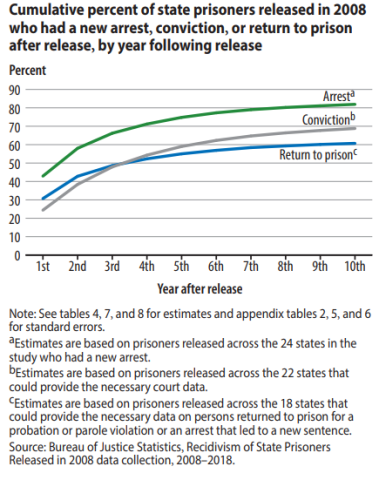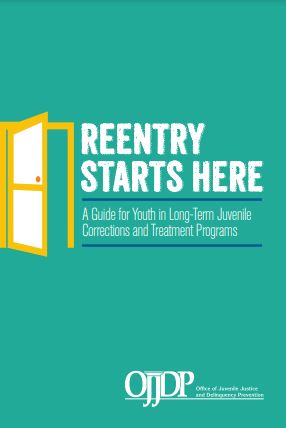Nearly 1.8 million Americans were incarcerated in prisons or jails at the end of 2021.
Most of these people will be released and reenter their communities, some to transitional housing and/or community supervision upon release, but many will be unprepared for reentry, the process by which a person in correctional confinement prepares for release and transitions back into the community.
According to a 2021 report from the Bureau of Justice Statistics (BJS), about 66% of persons released from state prisons across 24 states in 2008 were arrested within three years after release, and 82% were arrested within ten years.
Reentry programs give people the support they need to successfully return to their communities after incarceration and can greatly improve public safety. These programs can be delivered in a correctional institution or in the community upon release, but effective reentry planning should start long before release.
Types of Reentry Programming
The risks and needs of individuals returning home from incarceration are often unique. The programs and services programs offered to returning individuals should address their critical needs such as housing, employment, family unification, and treatment for substance use, mental, and physical health as necessary.
When implementing reentry programming, research supported by the National Institute of Justice (NIJ) found staff buy-in to be a critical factor in the success of the reentry program. It's critical for community corrections staff to implement programs with fidelity, and understand the process of the new program and approach their jobs in different ways. This can be challenging for any agency, especially those with limited staff. Read NIJ’s Five Things About Reentry for more information on what is known about how to encourage successful reentry based on decades of research and data.
For some people, their criminal record can be a barrier to finding stable housing and employment, which increases their risk of committing a new crime. Expungement of past charges, where appropriate, can improve their options in the community and decrease recidivism risks.
The Bureau of Justice Assistance (BJA) supported developing Planning a Reentry Program: A Toolkit for Tribal Communities to support tribal justice system practitioners in creating or enhancing reentry programs.
The Office of Juvenile Justice and Delinquency Prevention (OJJDP) developed Reentry Starts Here: A Guide for Youth in Long-Term Juvenile Corrections and Treatment Programs to help young people prepare for reentry into the community. The guide discusses planning for reentry and explains some of the services available to youth upon release.
The Second Chance Act
Starting in 2008, the Second Chance Act authorized federal grants to government agencies and nonprofit organizations to provide reentry services and programs.
Second Chance policies aim to remove barriers to reentry for returning citizens and improve their participation in the economy. As a result, Second Chance programs may enhance public safety by breaking the cycle of criminal recidivism and improving outcomes for people returning from prisons, jails and juvenile facilities.
Second Chance grantees supported by OJP provide vital services to make a person’s transition from prison or jail safer and more successful.
See the YouTube Terms of Service and Google Privacy Policy
Reentry Funding
In FY22, OJP program offices awarded nearly $100 million to help reduce recidivism and support reentry programs nationwide.
BJA helps state, local and tribal jurisdictions improve the capacity and effectiveness of their reentry programs to increase the chances for success of persons returning to their communities after incarceration.
Juvenile reentry and community supervision programs supported through OJJDP help ensure that youth have the opportunities to become productive, law-abiding members of society upon returning to their communities.
Between FY20-22, OJJDP awarded more than $43 million to programs supporting youth reentry and family engagement.
NIJ has also long supported projects focused on reentry, granting over $25 million for reentry-related research between FY18 and FY23.
OJP grants that support reentry initiatives can be found on the OJP Current Funding Opportunities page.
How OJP Supports Reentry Programs
April is Second Chance Month, a time to highlight the importance of supporting safe and successful reentry for those returning home from incarceration each year. Each April, offices across OJP celebrate Second Chance Month with various activities to draw attention to these important programs and policies.
The BJA- and OJJDP-supported National Reentry Resource Center is the nation’s primary source of information and guidance on reentry. Through its vast collection of tools and training opportunities, the Center supports implementing evidence-based reentry programs.
Research and evaluation supported by NIJ covers a wide range of reentry-related issues, including a series of three white papers that discuss specific challenges in reentry, an overview of recent NIJ investments in reentry, recommendations for web- and application-based tools to facilitate reentry planning, and a recent Justice Today podcast, From Successful Reentry to Stronger Communities.
More on Reentry from OJP
Visit the following pages for additional information and resources produced or sponsored by the Office of Justice Programs and other federal agencies:
| Reentry Publications & Multimedia | Rentry Training & Technical Assistance | Reentry Additional Resources |
OJJDP's Reentry Guide
This toolkit for youth in juvenile corrections and treatment programs is intended to assist them in preparing for reentry and success in the community.




